The frozen SWT reserve at Knockshinnoch had a grand total of 7 birds today: one Heron, 2 Mallard, Teal and one Water Rail. The latter gave one of the best views I’ve ever had as it ventured out onto the partially melting ice to feed. It came within 3m and totally ignored me and a mad Springer Spaniel. I managed to get a couple of shots and a bit of video (with a compact camera, so don’t expect BBC HD). As this was the first photo of a Water Rail I even managed to get an entry on the Ayrshire Species List – which just shows that anyone can do it with a bit of luck!
Author Archives: Kev
Contents of 2009 Report
124 pages including 13 pencil drawings and 23 photographs:
- Introduction by Fraser Simpson
- Kilkerran Re-visited: What’s happening to our summer visitors? by Angus Hogg
- The Kestrel in Ayrshire 2009 by Gordon Riddle
- Sparrowhawk Breeding Details 2009 by Ian Todd
- Chronological Summary by Angus Hogg
- Systematic List by Fraser Simpson
- Recent Rarities in Ayrshire: Franklin’s Gull & Yellow-browed Warbler by Bruce Kerr
- Ayrshire Butterfly Reports 2008-2009 by Fraser Simpson
Wetland Bird Survey in Ayrshire
The survey began in 1947 and today there are around 3000 volunteer counters who participate in synchronised monthly counts at wetlands of all habitat types, mainly during the winter period.
WeBS is a partnership between:
- British Trust for Ornithology;
- Royal Society for the Protection of Birds;
- Joint Nature Conservation Committee (the latter on behalf of Natural England, Scottish Natural Heritage, the Countryside Council for Wales and the Environment and Heritage Service for Northern Ireland) in association with the Wildfowl & Wetlands Trust.
Whilst Ayrshire may not rival some of the larger estuarine areas within Scotland it does have 134km of coastline and numerous inland water sites which fall under the scrutiny of the WeBS. Click on the following link to see coverage within Ayrshire. There are 45 sites registered for Ayrshire and currently only 15 are regularly counted for WeBS, so there is plenty of scope for people to get involved.
WeBS Core Counts
WeBS Core Counts are made annually at around 2,000 wetland sites of all habitats. Monthly co-ordinated counts are made, mostly by volunteers. The principal months of data collection are from September to March although, increasingly, observations are submitted from the summer months also.
How do we collect the data?
- WeBS Core Counts are made using so-called “look-see” methodology (Bibby et al. 2000), whereby the observer, familiar with the species involved, surveys the whole of a predefined area.
- Counts are made at all wetland habitats.
- Numbers of all waterbird species, as defined by Wetlands International (Rose & Scott 1997), are recorded. In the UK, this includes divers, grebes, cormorants, herons, Spoonbill, swans, geese, ducks, rails, cranes, waders and Kingfisher.
- Counts of gulls and terns are optional.
- In line with the recommendations of Vinicombe et al. (1993), records of all species recorded by WeBS, including escapes, are collected to contribute to the proper assessment of naturalised populations and escaped birds.
- Species present in relatively small numbers or dispersed widely may be counted singly.
- The number of birds in large flocks is generally estimated by mentally dividing the birds into groups, which may vary from five to 1,000 depending on the size of the flock, and counting the number of groups.
- Notebooks and tally counters may be used to aid counts.
- Counts are made once per month, ideally on predetermined “priority dates”. This enables counts across the whole country to be synchronised, thus reducing the likelihood of birds being double counted or missed.
How do we record the data?
Once the data has been collected there are a number of ways to record it:
- Firstly, the traditional method has been to record your sighting on a hard copy WeBS form. Once the seasons count have been completed the form gets sent to the Local Co-ordinator who passes on all of the information directly to the WeBS office at the BTO.
- The second method is one more in line with modern technology in that the individual records their observations directly onto the WeBS website. This reduces the need for paper copies, cuts out expenditure on postage and allows the individual to use the website tools to look at things like distribution and number of birds seen for your personal WeBS patch. We are encouraging people to use this second option but for those without regular access to the internet the first option remains open.
Benefits of on-line recording include:
- Paper free storage to record your sightings;
- Easy access to your data;
- Electronic quick searches of your data;
- Easy production of graphs with your data.
If you are interested in getting involved go to the WeBS website for further information or contact the local WeBS Co-ordinator.
References
- Bibby, C.J., Burgess, N.D., Hill, D.A. & Mustoe, S. (2000) Bird Census Techniques. Second Edition, Academic Press, London.
- Rose, P.M. & Scott, D.A. (1997) Waterfowl Population Estimates. Second Edition Wetlands International Publ. 44, Wageningen, The Netherlands.
- Vinicombe, K., Marchant, J. & Knox, A. (1993) Review of status and categorization of feral birds on the British List. British Birds, 75: 1-11.
Waxwing Invasion
Angus Hogg has sent in a nice set of pictures of the recent Waxwing invasion. This group was in Prestwick on 10th November and part of a larger group of birds. Click on the thumbnails below to see the full pictures.
Craigdullyeart and Corsencon
Location and Access
 Built alongside the River Nith, the village of New Cumnock is approximately 22km from Ayr and about the same distance from Kilmarnock on the A76 Dumfries road. Craigdullyeart Hill (NS 659 159) lies to the north-east of the village and is reached by turning off the A76 (just before the black and white chevron sign) onto the unclassified road at Pathhead / Mansefield about a kilometre from the roundabout at the western end of the village. Continue along this road past Mansefield Mains and Meikle Garclaugh and you will see Corsencon Hill directly ahead.
Built alongside the River Nith, the village of New Cumnock is approximately 22km from Ayr and about the same distance from Kilmarnock on the A76 Dumfries road. Craigdullyeart Hill (NS 659 159) lies to the north-east of the village and is reached by turning off the A76 (just before the black and white chevron sign) onto the unclassified road at Pathhead / Mansefield about a kilometre from the roundabout at the western end of the village. Continue along this road past Mansefield Mains and Meikle Garclaugh and you will see Corsencon Hill directly ahead.

Just past the second farm there’s a junction and a give-way sign, go straight on here and you will see Craigdullyeart Hill to the left. The road at this point is quite narrow and winds up the valley between Corsencon and Craigdullyeart for about 2 kilometres. Once you reach the end of the tarmac at the top of the hill there is a gravel track which runs into a large spruce plantation to the north-east.
![]() Off-road tracks unsuitable for wheelchair users. -4 places to stop on road and view glen. Turning space at top good for birds.
Off-road tracks unsuitable for wheelchair users. -4 places to stop on road and view glen. Turning space at top good for birds.
![]() Quiet byways with some steep gradients.
Quiet byways with some steep gradients.
Access Update
Following the completion of open-cast mining operations, all entry restrictions have been removed, the coal conveyor has been dismantled and the area landscaped. Access to Glen Farm from Mansfield Road, New Cumnock is on a newly improved tarmac road which ends at a small parking area. After this the access road is currently in poor condition for driving but easily walkable. A wind turbine development is proposed for part of this area which may improve access in the future.
Mike Howes, February 2017Birds
The area around Craigdullyeart is a mixture of farmland, heather moorland and conifer plantation, creating a mosaic of habitats which attracts a variety of different birds. Exploring the area on foot is obviously the best option, but if you are driving the following technique can be very useful. Go all the way to the top of the road (where the tarmac ends), spend some time scanning along the drystane dykes which run along the bottom of Corsencon on the left, then slowly drive back down using your car as a mobile hide. This allows good close views of birds on either side of the road and you can stop at a number of vantage points which look out over the glen and surrounding countryside. At the top of the glen where the large Sitka Spruce plantation begins, Skylark, Reed Bunting and Lesser Redpoll can be found, (watch out for Skylarks perching on the fire-beaters by the side of the road), this is also a good area to look for Crossbill. As you come back down the glen, the young plantations on either side of the road are excellent for Stonechat, Whinchat and Meadow Pipit. There is a Black Grouse lek on the lower slope of Corsencon which can be observed from near the top of the road, there are sometimes up to 6 birds here during the breeding season. At other times Black Grouse can be seen amongst the small trees in the plantations or perched up on the drystane dykes which criss-cross the site. Short-eared Owl also breed in the glen, but only seem to do so in years when Field Voles are abundant. Kestrel can always be seen, Sparrowhawk have nested in one of the plantations and there is usually a Buzzard or two over the hill. Curlew are particularly noticeable flying up and down the glen during the breeding season. The lower part of the site where the farmland begins is worth a look for species such as Yellowhammer, Linnet and Bullfinch. In summer the area holds plenty of Warblers and Hirundines and in winter the fields can be covered in Thrushes and Starlings. Early summer is probably the best time for a visit, although there is a fair chance that migrants could be located on Corsencon at the appropriate times during spring and autumn passage.
Other Information
By following the unclassified road down past Merkland Farm and the front of Corsencon, excellent views can be had over the floodplain of the River Nith where there are often flocks of geese in the winter. To do this, turn left at the road junction on your way back down the glen.
New Cumnock is reasonably well served by public transport, regular buses run from Cumnock and there is a frequent train service from Glasgow / Kilmarnock. The main bus service is the No 43 which leaves The Tanyard in Cumnock twice an hour. Trains from Glasgow and Kilmarnock (or stations in between) are either Carlisle or Newcastle services and run approximately every hour although the times do vary throughout the day. Craigdullyeart and the other nearby New Cumnock sites would be well suited for cycling around as the back roads around the village are fairly quiet. Cycling birders would however be well advised to avoid the A76 outside the boundaries of the village as this is one of the busiest roads in this part of the county.
Gazetteer
The Ayrshire Bird Report names the places where sightings took place. Often these are the hot-spots listed in the Where to Watch Birds in Ayrshire section. However, for many records the place might not be so well known. The table below lists the places mentioned in the 1999 Bird Report (a typical year, I hope) together with the OS grid reference to identify the location. The table is sorted alphabetically, but as there are over 160 entries, it might be more efficient to use your browser’s Find facility. The following OS Landranger 1:50,000 scale maps cover this area:
- 63: Firth of Clyde area
- 64: Glasgow and surrounding area
- 70: Ayr, Kilmarnock and surrounding area
- 71: Lanark and surrounding area
- 76: Girvan, Ballantrae and Barrhill
- 77: Dalmellington and New Galloway
| Place Name | Grid Reference | OS Map |
|---|---|---|
| Ailsa Craig | NX019998 | 76 |
| Airds Moss | NS600240 | 71 |
| Alloway (Ayr) | NS334185 | 70 |
| Ardeer | NS280410 | 70 |
| Ardmillan | NX168946 | 76 |
| Ardneil Bay | NS185484 | 63 |
| Ardrossan | NS225420 | 63, 70 |
| Ashgrove Loch | NS274443 | 70 |
| Auchincruive | NS385235 | 70 |
| Auchinharvie (Stevenston) | NS263415 | 70 |
| Ayr Gorge | NS463256 | 70 |
| Ayr Harbour | NS333227 | 70 |
| Balcreuchan Port | NX100878 | 76 |
| Balkenna | NS198043 | 76 |
| Ballantrae | NX083827 | 76 |
| Baltersan | NS284086 | 76 |
| Bankhead | NS486374 | 71 |
| Barassie | NS322314 | 70 |
| Barcraigs Reservoir | NS394574 | 63 |
| Barcully | NS316048 | 77 |
| Bargany | NS244003 | 77 |
| Barnshean Loch | NS380114 | 70 |
| Barskimming | NS483245 | 70 |
| Beith | NS350540 | 63 |
| Bennane Head | NX091867 | 76 |
| Bennane Lea | NX092860 | 76 |
| Black Loch | NS591162 | 71 |
| Blackcraig Hill | NS648065 | 77 |
| Blacksidend | NS583296 | 71 |
| Blackwater Loch | NX080783 | 76 |
| Blairbowie | NS326114 | 70 |
| Blairquhan | NS366054 | 70 |
| Bogside (Irvine) | NS307400 | 70 |
| Bogton Loch | NS470054 | 70 |
| Brackness Hole | NX051768 | 76 |
| Braehead | NS599218 | 71 |
| Brest Rocks | NS193050 | 70 |
| Brickwork Loch | NS591225 | 71 |
| Burn Foot | NX051763 | 76 |
| Burnhouse | NS384503 | 70 |
| Cairnhill (near Dailly) | NS235005 | 76 |
| Capringstone Farm | NS358389 | 70 |
| Catrine | NS530258 | 70 |
| Corsehouse | NS478503 | 64 |
| Corsehouse Reservoir | NS480500 | 64 |
| Coylton | NS407200 | 70 |
| Craigdow Loch | NS263065 | 70 |
| Crosshill | NS326066 | 70 |
| Croy | NS245127 | 70 |
| Culzean | NS231099 | 70,76 |
| Cunninghamhead | NS377419 | 70 |
| Currarie Port | NX055780 | 76 |
| Daljarrock | NX195882 | 76 |
| Dalmellington | NS480060 | 70 |
| Dalquharran Moss | NS273025 | 77 |
| Dalry | NS291495 | 70 |
| Dalrympleston Marsh | NS440211 | 70 |
| Darnconner | NS575240 | 71 |
| Dean Castle County Park (Kilmarnock) | NS440396 | 70 |
| Deil�s Dyke | NS306194 | 70 |
| Dipple | NS200026 | 76 |
| Doonfoot | NS324195 | 70 |
| Doonholm | NS339175 | 70 |
| Downan Point | NX068806 | 76 |
| Dreghorn (Irvine) | NS352379 | 70 |
| Drumshang | NS245140 | 70 |
| Drybridge | NS360366 | 70 |
| Dunure | NS253160 | 70 |
| Dyke Foot | NX046735 | 76 |
| Eglinton Country Park (Irvine) | NS320420 | 70 |
| Fairlie | NS217546 | 63 |
| Fenwick | NS465434 | 70 |
| Fergus Loch | NS393183 | 70 |
| Finnarts Point | NX046741 | 76 |
| Gala Lane | NX476915 | 76 |
| Games Loup | NX103881 | 76 |
| Garnock Floods (Irvine) | NS305417 | 70 |
| Girdle Toll (Irvine) | NS345405 | 70 |
| Girvan | NX183982 | 76 |
| Glenbuck Loch | NS755287 | 71 |
| Greenan | NS313191 | 70 |
| Guelt Water | NS660180 | 71 |
| Heads of Ayr | NS284188 | 70 |
| Heart Loch | NS311094 | 70 |
| Hessilhead | NS382532 | 63 |
| Horse Island (Ardrossan) | NS213427 | 70 |
| Hunterston | NS190520 | 63 |
| Irvine Bay | NS304379 | 70 |
| Irvine Beach Park | NS308375 | 70 |
| Kennedy’s Pass | NX150933 | 76 |
| Kilantringan Loch | NX090790 | 76 |
| Kilbirnie Loch | NS330545 | 63 |
| Kileekie | NS321063 | 70 |
| Kilkerran | NS310035 | 76 |
| Kirkmichael House | NS341084 | 76 |
| Knockdolian | NX118848 | 76 |
| Knockshinnoch lagoons | NS430143 | 71 |
| Knockytoul | NX275805 | 76 |
| Largs | NS201595 | 63 |
| Lendalfoot | NX131900 | 76 |
| Loans | NS346318 | 70 |
| Loch Derclach | NX445989 | 76 |
| Loch Doon | NX477000 | 76 |
| Loch Dornal | NX295764 | 76 |
| Loch Finlas | NX469979 | 76 |
| Loch Maberry | NX285758 | 76 |
| Loch Macaterick | NX440913 | 76 |
| Loch Melemon | NX120860 | 76 |
| Loch Nahinie | NX278771 | 76 |
| Loch of the Lowes (New Cumnock) | NS602146 | 71 |
| Loch Riecawr | NX435935 | 76 |
| Lochhill | NS468231 | 70 |
| Lochingerroch | NS623095 | 71 |
| Lochlea | NS455302 | 70 |
| Loudonston Farm | NS437213 | 70 |
| Loudoun Castle | NS506378 | 70 |
| Lugar | NS594214 | 71 |
| Maidens | NS215083 | 70 |
| March Burn | NX046750 | 76 |
| Martnaham Loch | NS390170 | 70 |
| Maybole | NS300100 | 70 |
| Meikle Craigs | NS325286 | 70 |
| Merkland | NS249071 | 70 |
| Milton Burn | NS201054 | 70 |
| Minishant | NS326140 | 70 |
| Mochrum Loch | NS270092 | 70 |
| Monkwood | NS340147 | 70 |
| Munnoch Reservoir | NS248475 | 63 |
| Myremill | NS320106 | 70 |
| Nebbock Rocks (Saltcoats) | NS241411 | 70 |
| Nether Auchendrane | NS335166 | 70 |
| New Cumnock | NS616133 | 71 |
| Newton (Ayr) | NS338234 | 70 |
| North Craig Reservoir | NS437414 | 70 |
| Oldhall | NS340364 | 70 |
| Penwhapple Reservoir | NX261975 | 76 |
| Pinbain Quarry | NX138914 | 76 |
| Polquhirter Meadows | NS635135 | 71 |
| Port Vad | NX093869 | 76 |
| Portencross | NS175486 | 63 |
| Pow Burn | NS345277 | 70 |
| Prestwick | NS345255 | 70 |
| Priestland | NS578374 | 71 |
| Raith Reservoir | NS395271 | 70 |
| Raithhill | NS409183 | 70 |
| Rankinston | NS451144 | 70 |
| Rosemount | NS375291 | 70 |
| Rozelle (Ayr) | NS340190 | 70 |
| Saltcoats | NS241411 | 70 |
| Seamill | NS200471 | 63 |
| Shankston Loch | NS349119 | 70 |
| Shewalton (Irvine) | NS320371 | 70 |
| Skelmorlie | NS193675 | 63 |
| Southannan | NS208540 | 63 |
| Stair | NS440234 | 70 |
| Starling Knowe | NX053721 | 76 |
| Stevenston Point | NS269401 | 70 |
| Swindridge | NS329498 | 63 |
| Tairlaw | NS403009 | 77 |
| Tarbolton | NS432273 | 70 |
| Tarfessock | NX363883 | 76 |
| Tarryholm (Irvine) | NS327382 | 70 |
| Trabboch Loch | NS436218 | 70 |
| Troon | NS310310 | 70 |
| Turnberry Point | NS196073 | 70,76 |
| Warrix (Irvine) | NS336373 | 70 |
| Warwickdale (Irvine) | NS368399 | 70 |
| West Kilbride | NS210480 | 63 |
| Whitehill | NS405169 | 70 |
Breeding Stonechats in Ayrshire
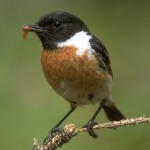
Following a prolonged, severe cold period during the second half winter 2009-10, it was obvious that many small birds had suffered a heavy casualty rate. Most inland pairs of Stonechats were wiped out and, based on evidence gathered so far, many of the coastal pairs suffered a similar fate. This kind of thing has happened before, and the species will, doubtless,bounce back. However, it would be useful to know just how bad the situation is prior to the recovery.
I’d be really grateful if anyone with observations of single territorial males, or breeding pairs of Stonechats anywhere in Ayrshire this year could send their records to me (please include the site name and, if possible, a grid reference) before mid November. I’m hoping to write up a short note in the SOC Ayr Branch Newsletter outlining the current breeding status of our county bird. The deadline for inclusion in the newsletter is late November.
Ardrossan to Brodick “Pelagic”
Location and Access
The Calmac ferry to the Isle of Arran goes between Ardrossan and Brodick and offers the chance to see birds out in the Firth of Clyde on a trip that takes just under an hour each way. The ferry is big and only gets bumpy in really bad weather. There is outdoor seating on various decks for observing (it is even possible to look out of the windows in the cafeteria and observation lounge:-).
On Saturdays during July and August the North Ayrshire branch of the RSPB have a stand at the rear of the ship to show passengers the wildlife en route (and do a very successful RSPB recruitment!).
![]() Ferry is equipped with lift to transport wheelchair users from car deck to upper deck.
Ferry is equipped with lift to transport wheelchair users from car deck to upper deck.
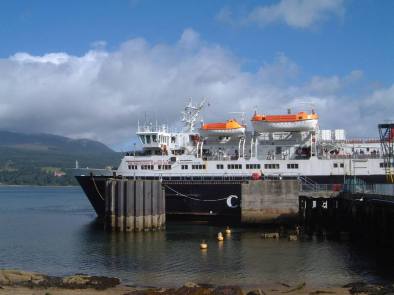
Birds
As the boat leaves Ardrossan harbour you get a decent view of Horse Island (NS213427). This is an RSPB reserve with a large colony of Eider and Lesser Black-backed Gull, with Cormorant, Shag and Greylag Goose. There is no access to the island, so the ferry makes a good vantage point. Ardrossan Harbour is also a good location for seeing Black Guillemot at close range.
When in mid-firth the birds to look out for include Manx Shearwater and Storm Petrel (especially in autumn), Gannet (on fishing trips from Ailsa Craig), Fulmar, the three commoner species of Diver.
As the ferry approaches Brodick you pass the refuse tip with its attendant gulls. In winter these are obviously worth scanning for white-winged gulls such as Glaucous and Iceland.
The ferry is also good for other marine wildlife: e.g. porpoise, Atlantic grey seal, common seal, Minke whale. The Firth is also important for the enigmatic Basking Shark.
Additional Information
For more general information on Arran (e.g. ferry details) please see the Arran page.
Shewalton Area
Location and Access
This part of south Irvine is actually a collection of six areas good for wildlife all within two kilometres of each other. These are mostly managed by the Scottish Wildlife Trust. For convenience they can be split into two groups which we’ll call North and South.
North Shewalton
For this group it is recommended you park in the small reserve layby just off the A737 at NS 26 70: heading north into Irvine from the Shewalton junction of the A78 it is on the right just after Shewalton Cemetery.
Area One: Shewalton Sandpits
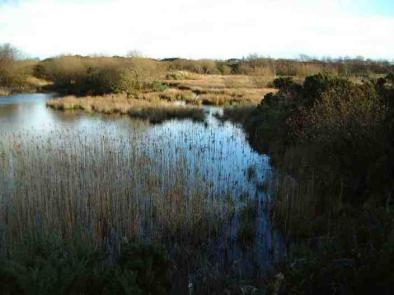
![]() From the layby go down the path to the reserve. There are a couple of ponds surrounded by scrub and reeds. This area was reclaimed from disused sand and gravel works. It is particularly interesting for plants and butterflies. Extensive work done by the SWT in 2009-10 has restored this area, especially the ponds and cleared the network of paths. These go round the ponds and over to the River Irvine.
From the layby go down the path to the reserve. There are a couple of ponds surrounded by scrub and reeds. This area was reclaimed from disused sand and gravel works. It is particularly interesting for plants and butterflies. Extensive work done by the SWT in 2009-10 has restored this area, especially the ponds and cleared the network of paths. These go round the ponds and over to the River Irvine.
Area Two: Trocol Pond
From the layby walk back and cross the A737 and enter the area via a gate at NS 25 71. A circular path goes round a pond with stretches of wood, gorse and scrub. The pond has Coot, Moorhen and breeding Mute Swan. In winter it also attracts Whooper Swan. The trees (a mixture of conifer and deciduous) support Siskin, various tits, finches and the commoner summer migrants.
South Shewalton
The second group is on the other side of the A78. For this group it is recommended you park in the small SWT reserve car park near the paper factory at NS 7 57. From the Meadowhead Roundabout head towards the paper factory and pass the water treatment works on the left, after which a small track on the left goes down to the car park. This is on National Cycle Route 7.
Area Three: Shewalton Woods
![]() From the car park follow the cycle path to start a circular walk that would take roughly an hour. Almost immediately take a track on the left and follow a water pipeline to some ponds at NS 49 61. The ponds and surrounding scrub have Grasshopper Warbler, Whitethroat, Reed Bunting and Sedge Warbler in summer, and the adjacent fields have Whooper Swans, Teal, Redwing and Fieldfares in winter. Map
From the car park follow the cycle path to start a circular walk that would take roughly an hour. Almost immediately take a track on the left and follow a water pipeline to some ponds at NS 49 61. The ponds and surrounding scrub have Grasshopper Warbler, Whitethroat, Reed Bunting and Sedge Warbler in summer, and the adjacent fields have Whooper Swans, Teal, Redwing and Fieldfares in winter. Map ![]()
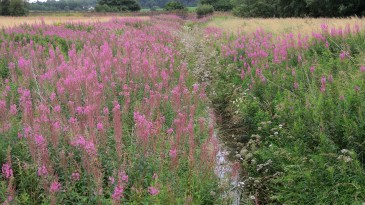
The path continues and enters a section of birch woodland which has Coal Tit, Goldcrest, Long-tailed Tit, Siskin, Great Spotted Woodpecker, and Redpoll. You emerge from the trees into a large expanse of rough grassland on the former raised bog, remnants of which persist close to the capped landfill site in the centre of, but not officially part of, the reserve. Buzzards breed and Hen Harrier is a winter visitor over the Moss. Foxes and Roe Deer are commonly seen. Keep your eyes peeled for adders basking on the edge of the path. The Moss is where I always get the first singing Skylark of the spring.
The path continues along the side of the Troon-Kilmarnock railway line (still in use, though only occasional trains pass) and rejoins the National Cycle Route at the south end of the paper factory. The trees here have Woodcock as well as the usual suspects. In 2009 15 hectares of conifer circling the reserve were felled to convert the area to native broad-leaved woodland. This is rapidly being colonised with wild flowers, and native tree species. A project The Shewalton Wood Tree Nursery is underway to provide a source of trees grown from seeds of Ayrshire provenance for use in local reserves.
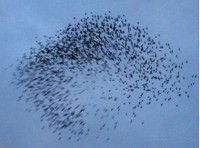
In winter at dusk it is worth visiting the paper factory carpark to watch the roosting Starling flocks come in. These often attract Sparrowhawks which adds to the excitement!
Area Four: Meadowhead Pit
From the car park walk back towards Meadowhead Roundabout and opposite the pumping station (NS 6 59) take the cycle path to the left (signposted to Irvine Station). After about 200m the flooded pit appears on the right (NS 3 63). Gulls rest here after a busy scavenge in the local tip. Cormorant, Coot and Little Grebe all breed. In winter ducks such as Tufted Duck, Scaup, Pochard, Goldeneye are common as well as occasional visitors such as Goosander and Long-tailed Duck and swans (Mute, Whooper and even Black!).
Area Five: Gailes Marsh
![]() By continuing along the cycle path from Area Four a foot bridge crosses the A78 and emerges at a busy minor road. Cross this and turn right towards the mini-roundabout. Continue along the cycle path as it heads left. After 400m on the left is Gailes Marsh: another SWT reserve. It is also possible to park on the grass verge at the edge of the reserve near the water pumping building.
By continuing along the cycle path from Area Four a foot bridge crosses the A78 and emerges at a busy minor road. Cross this and turn right towards the mini-roundabout. Continue along the cycle path as it heads left. After 400m on the left is Gailes Marsh: another SWT reserve. It is also possible to park on the grass verge at the edge of the reserve near the water pumping building.
Cross the style to enter the reserve which comprises coastal grassland, open water, marsh and woodland combine that supports a diversity of plant and animal life. It is particularly important for plants, amphibians and butterflies (work to re-introduce the Small Blue started in 2010).
In 2010 an artificial Sand Martin colony was constructed at the south of the reserve. This proved to be an immediate hit with 15-20 pairs moving in that spring.
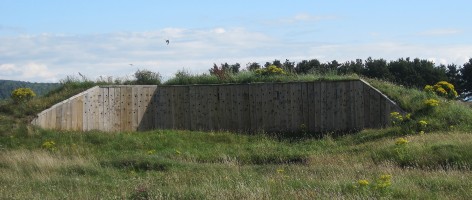
Area Six: Oldhall Ponds
![]() It is easy to overlook this SWT reserve as it hides away in the area north-west of the Meadowhead roundabout on the B7080. It consists of a couple of ponds connected by a path leading to a viewpoint. Although not a major attraction on its own, when combined with the other sites in this group, it nicely rounds off a visit. Parking is a little tricky as this road is busy: the best idea is to park nearer the paper factory and walk. Map of boundary
It is easy to overlook this SWT reserve as it hides away in the area north-west of the Meadowhead roundabout on the B7080. It consists of a couple of ponds connected by a path leading to a viewpoint. Although not a major attraction on its own, when combined with the other sites in this group, it nicely rounds off a visit. Parking is a little tricky as this road is busy: the best idea is to park nearer the paper factory and walk. Map of boundary ![]()
The ponds attract the usual waterfowl including Whooper Swan in winter, and Kingfisher. The scrub area is also good for the usual summer migrants.
Culzean
Location and Access
![]() Culzean Country Park is the most popular National Trust for Scotland (NTS) property attracting 200,000 visitors annually. It is situated on the Firth of Clyde, 19 km south of Ayr on the A719, 6 km west of Maybole, off the A77. There is a range of visitor facilities including car parking, refreshment points, exhibitions, information and toilets. The main areas of the Park are accessible for disabled visitors. Ranger-led walks can be booked for groups and an events programme is available from Easter to the end of September.
Culzean Country Park is the most popular National Trust for Scotland (NTS) property attracting 200,000 visitors annually. It is situated on the Firth of Clyde, 19 km south of Ayr on the A719, 6 km west of Maybole, off the A77. There is a range of visitor facilities including car parking, refreshment points, exhibitions, information and toilets. The main areas of the Park are accessible for disabled visitors. Ranger-led walks can be booked for groups and an events programme is available from Easter to the end of September. 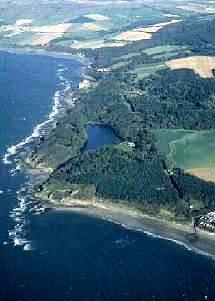
A regular bus service to Maidens passes the entrance. An approach bycycle along A719 is feasible, though particular care should be exercised when tourist traffic is at a peak.
Please note that there is an admission charge between mid-March and the end of October for people who are not members of the NTS.
<![]() Several car parks throughout park. Woodland: partially accessible by wheelchair along main paths, uneven surface in places, ramp to hide at Swan Pond.
Several car parks throughout park. Woodland: partially accessible by wheelchair along main paths, uneven surface in places, ramp to hide at Swan Pond.
![]() A719 approach needs care, but cycling is good within the grounds.
A719 approach needs care, but cycling is good within the grounds.
Status
Culzean is a typical Scottish lowland estate covering around 600 acres. Its heritage status is due to the exceptional designed landscape and Robert Adam’s magnificent clifftop castle. In addition to the fifty traditional buildings, Culzean has mixed mature woodland, 130 acres of farmland, two major gardens, freshwater ponds and five kilometres of coastline. The sandy bays, rocky shoreline and hundred foot cliffs are part of the Maidens to Dunure Site of Special Scientific Interest, the best example of coastal deciduous woodland in Southern Scotland. Following a survey by the Scottish Wildlife Trust’s wildlife sites team the Country Park was confirmed as a Listed Wildlife Site because of its significant wildlife interest.
Birds
The combination of mixed woodland in a coastal setting provides a wide range of habitats and a resultant healthy bird list of 110 to 120 species annually of which around 50 breed.
Woodland
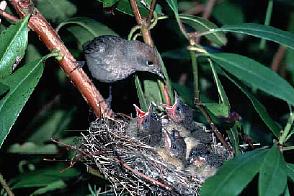 From April to June the main woodland interest is the breeding warblers with around 100 pairs breeding annually. Blackcap, Chiffchaff and Willow Warbler are common with smaller number of Garden Warbler, Whitethroat, Grasshopper and Sedge Warbler and occasionally Wood Warbler. Other breeding birds of note are Barn Owl, Kestrel, Sparrowhawk, Tawny Owl, Stock Dove, Great Spotted Woodpecker, Bullfinch, Goldfinch and Siskin. Several kilometres of pathway are kept open throughout the woodland and patience is very often rewarded. In winter the shelter of the woodland is a haven for Redwing and Woodcock during severe weather. Mixed flocks of Goldcrest, Long-tailed, Coal, Great and Blue Tits are a winter feature often numbering 80-100 birds.
From April to June the main woodland interest is the breeding warblers with around 100 pairs breeding annually. Blackcap, Chiffchaff and Willow Warbler are common with smaller number of Garden Warbler, Whitethroat, Grasshopper and Sedge Warbler and occasionally Wood Warbler. Other breeding birds of note are Barn Owl, Kestrel, Sparrowhawk, Tawny Owl, Stock Dove, Great Spotted Woodpecker, Bullfinch, Goldfinch and Siskin. Several kilometres of pathway are kept open throughout the woodland and patience is very often rewarded. In winter the shelter of the woodland is a haven for Redwing and Woodcock during severe weather. Mixed flocks of Goldcrest, Long-tailed, Coal, Great and Blue Tits are a winter feature often numbering 80-100 birds.
Buildings
Swift use the nest boxes on the main buildings, House Martin have recently recolonised and the Swallow population is at saturation point, especially in the Walled Garden where every available nest site is used. Live images of one pair of nesting swifts in the exhibition loft have been relayed back to the information area and, although it is early days, we hope to improve the quality and that this will become an annual event.
Coastline
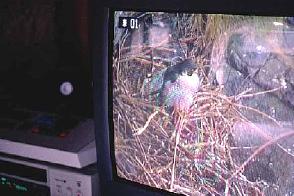 Another camera has been installed on the Castle cliffs and this has proved productive in recording Raven breeding, the daily life on the Fulmar colony (not spectacular!) and Peregrine Falcon nest prospecting. The Ravens and Peregrines are regularly seen in the air around the Castle. The coastal dimension is obviously a very important part of Culzean and the cliff walk has several locations which are ideal for sea watching, species varying with the season. Gannet and auks from Ailsa Craig can be seen in spring and summer while divers, grebes and the occasional influx of Manx Shearwater brighten up the winter scene.
Another camera has been installed on the Castle cliffs and this has proved productive in recording Raven breeding, the daily life on the Fulmar colony (not spectacular!) and Peregrine Falcon nest prospecting. The Ravens and Peregrines are regularly seen in the air around the Castle. The coastal dimension is obviously a very important part of Culzean and the cliff walk has several locations which are ideal for sea watching, species varying with the season. Gannet and auks from Ailsa Craig can be seen in spring and summer while divers, grebes and the occasional influx of Manx Shearwater brighten up the winter scene.
Swan Pond
The Swan Pond is probably more interesting in winter rather than spring and summer due to the build up of overwintering duck. Pochard, Tufted Duck and Goldeneye swell the numbers, though Mallard are still the commonest. You never know what to expect and in rough weather species more usually seen at sea, such asLong-tailed Duck, may put in an appearance and there are regular records of Gadwall, Pintail and Smew. Winter numbers of Little Grebe have recently built up to around 20. Look out for Heron roosting in the field adjacent to the Swan Pond car park, 19 is the highest count so far.
Spring at the Swan Pond is virtually a battlefield as numerous pairs of Mute Swan attempt to secure nesting territories. At least pairs eventually settle and build and one pair uses a quiet cove on the coast. Little Grebe, Water Rail and Tufted Duck are around all the time and the arrival of Lesser Black-backed Gull usually announces the broods of Mallard chicks being brought to the pond from their woodland nests.
Bird Checklist
Status as at February 2001 and including historical data.
| Red-throated Diver | Partridge | Swift | Jackdaw |
| Black-throated Diver | Pheasant | Kingfisher | Rook |
| GreatNorthern Diver | Water Rail | Great Spotted Woodpecker | Carrion Crow |
| LittleGrebe | Corncrake | Raven | Chough |
| Great Crested Grebe | Moorhen | Skylark | Starling |
| Red-necked Grebe | Coot | Sand Martin | House Sparrow |
| Slavonian Grebe | Oystercatcher | Swallow | Tree Sparrow |
| Fulmar | Ringed Plover | House Martin | Chaffinch |
| Manx Shearwater | Golden Plover | Tree Pipit | Brambling |
| Gannet | Grey Plover | Meadow Pipit | Greenfinch |
| Cormorant | Lapwing | Rock Pipit | Goldfinch |
| Shag | Purple Sandpiper | Grey Wagtail | Siskin |
| Bittern | Dunlin | Blue-headed Wagtail | Linnet |
| Little Bittern | Snipe | Pied Wagtail | Twite |
| Grey Heron | Woodcock | Dipper | Lesser Redpoll |
| Bewick Swan | Whimbrel | Wren | Mealy Redpoll |
| Mute Swan | Curlew | Dunnock | Crossbill |
| Whooper Swan | Redshank | Waxwing | Bullfinch |
| Bean Swan | Common Sandpiper | Robin | Yellowhammer |
| Pink-footed Goose | Turnstone | Redstart | Reed Bunting |
| Greylag Goose | Arctic Skua | Stonechat | Corn Bunting |
| Shelduck | Black-headed Gull | Wheatear | |
| Wigeon | Common Gull | Ring Ouzel | |
| Gadwall | Lesser Black-backed Gull | Blackbird | |
| Teal | Herring Gull | Fieldfare | |
| Mallard | Glaucous Gull | Song Thrush | |
| Pintail | Great Black-backed Gull | Redwing | |
| Garganey | Kittiwake | Mistle Thrush | |
| Shoveler | Sandwich Tern | Grasshopper Warbler | |
| Pochard | Common Tern | Sedge Warbler | |
| Tufted Duck | Arctic Tern | Lesser Whitethroat | |
| Scaup | Little Tern | Whitethroat | |
| Eider | Guillemot | Blackcap | |
| Long-tailed Duck | Razorbill | Garden Warbler | |
| Common Scoter | Black Guillemot | Wood Warbler | |
| Goldeneye | Rock Dove | Chiffchaff | |
| Smew | Stock Dove | Willow Warbler | |
| Red-breasted Merganser | Woodpigeon | Goldcrest | |
| Goosander | Collared Dove | Spotted Flycatcher | |
| Hen Harrier | Feral Pigeon | Pied Flycatcher | |
| Goshawk | Cuckoo | Long-tailed Tit | |
| Sparrowhawk | Barn Owl | Willow Tit | |
| Buzzard | Tawny Owl | Coal Tit | |
| Osprey | Long-eared Owl | Blue Tit | |
| Kestrel | Short-eared Owl | Great Tit | |
| Merlin | Nightjar | Treecreeper | |
| Peregrine Falcon | Jay | ||
| Magpie |
Additional Information
For further information please contact:
The Ranger ServiceThe Visitor Centre
Culzean Country Park
Maybole
Ayrshire
KA19 8LE
- Phone:
- 01655 884400
- Fax:
- 01655 884522
- Web:
- www.nts.org.uk





